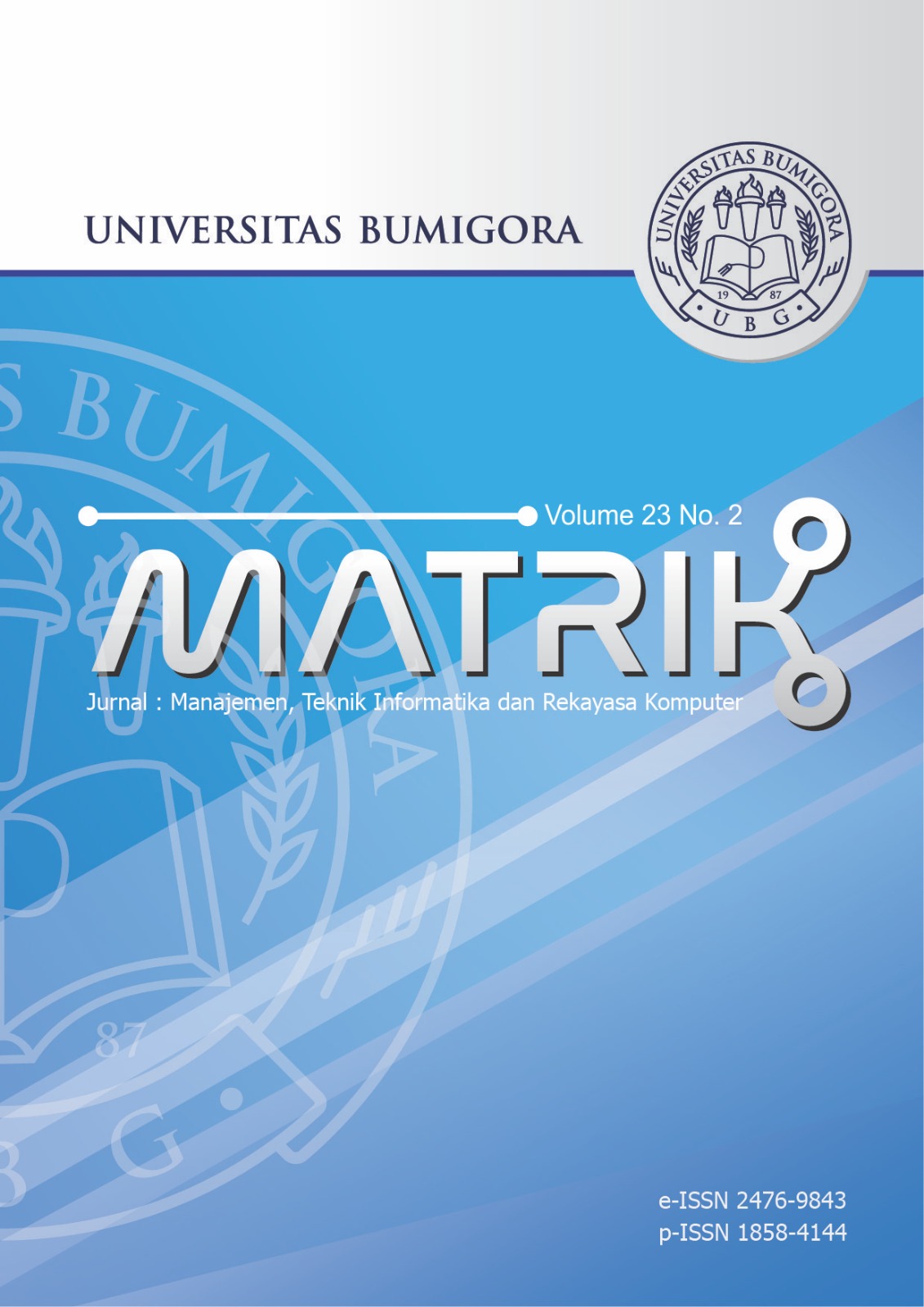Modeling the Farmer Exchange Rate in Indonesia Using the Vector Error Correction Model Method
DOI:
https://doi.org/10.30812/matrik.v23i2.3407Keywords:
Agriculture, Farmer Exchange Rate, Vector Error Correction Model, Vector Error Correction ModelAbstract
The agricultural sector plays a crucial role in the Indonesian economy. However, the farm sector still has serious problems, including agricultural product prices, which often fall when the harvest supply is abundant. So often, the income obtained is not proportional to the price spent by farmers, which has an impact on decreasing the welfare of farmers. An indicator to observe changes in the interest of Indonesian farmers is the Farmer Exchange Rate Index (NTP). This study aims to form a model and project the welfare level of farmers in Indonesia, focusing on NTP indicators, which are caused by the influence of variables such as inflation, Gross Domestic Product (GDP), interest rates, and the rupiah exchange rate. The method used is the Vector Error Correction Model (VECM), used when there are indications that the research variables do not show stability at the initial level and there is a cointegration relationship. The results of this study show that in the long run, significant factors affecting NTP are inflation, interest rates, and the rupiah exchange rate. Meanwhile, in the short term, the variables that have an impact are GDP and the rupiah exchange rate. The resulting VECM model shows a MAPE error rate of 1.79%, indicating excellent performance, as the MAPE error rate is below 10%. The implication of this research is provides information related to NTP projection that can be used to formulate strategies to strengthen Indonesia's agricultural sector.
Downloads
References
vol. 237, p. 121639, 2021, https://doi.org/10.1016/j.energy.2021.121639.
[2] D. Masru’ah, “Pengaruh Tenaga Kerja dan Investasi di Sektor Pertanian terhadap Pertumbuhan Sektor Pertanian di Provinsi
Jawa Timur,†Jurnal Mahasiswa Teknologi UNESA, vol. 6, no. 1, pp. 1–18, 2022.
[3] M. Z. Hasbunallah and A. Darmansyah, “Financing of the Agricultural Business by Sharia Bank to Increase the Exchange
Rate of Farmers in West Java Province,†International Journal of Current Science Research and Review, vol. 06, no. 07, pp.
4250–4265, 2023, https://doi.org/10.47191/ijcsrr/v6-i7-39.
[4] S. Syifa Aulia, D. Sulistiyo Rimbodo, and M. Ghafur Wibowo, “Faktor-faktor yang Memengaruhi Nilai Tukar Petani (NTP) di
Indonesia,†JEBA (Journal of Economics and Business Aseanomics), vol. 6, no. 1, pp. 44–59, 2021, https://doi.org/10.33476/j.
e.b.a.v6i1.1925.
[5] E. Marsudi, Y. Syafitri, and T. Makmur, “Faktor Faktor yang Mempengaruhi Nilai Tukar Petani Padi dan Perkembangannya di
Provinsi Aceh,†Jurnal Agrisep, vol. 21, no. 2, pp. 51–60, 2020.
[6] K. Annisa and I. Chandriyanti, “Analisis Faktor-Faktor Yang Mempengaruhi Nilai Tukar Petani Di Provinsi Kalimantan Selatan
Tahun 2009-2018,†JIEP: Jurnal Ilmu Ekonomi dan Pembangunan, vol. 4, no. 2, pp. 443–452, 2021.
[7] M. A. Sinaga, M. Y. Wardhana, and M. Usman, “Analisis Faktor-faktor yang Mempengaruhi Nilai Tukar Petani Komoditas
Nilam di Provinsi Aceh,†Jurnal Ilmiah Mahasiswa Pertanian, vol. 7, no. 2, pp. 244–251, 2022, https://doi.org/10.17969/jimfp.
v7i2.20018.
[8] M. Ankrah Twumasi, Y. Jiang, and M. Owusu Acheampong, “Capital and credit constraints in the engagement of
youth in Ghanaian agriculture,†Agricultural Finance Review, vol. 80, no. 1, pp. 22–37, 2020, https://doi.org/10.1108/
AFR-11-2018-0100.
[9] R. Huang, G. Luo, Q. Duan, and L. Zhang, “Using Baidu search index to monitor and predict newly diagnosed cases of HIV
/ AIDS , syphilis and gonorrhea in China : estimates from a vector autoregressive ( VAR ) model,†pp. 1–3, 2020, https:
//doi.org/10.1136/bmjopen-2019-036098.
[10] A. R. Alsaber, P. S. A. T. Al-sultan, and J. Pan, “Statistics for COVID-19 Pandemic Data Exploring the impact of air pollution
on COVID-19 admitted cases in Kuwait,†Japanese Journal of Statistics and Data Science, no. 5, pp. 379–406, 2022, https:
//doi.org/10.1007/s42081-022-00165-z.
[11] Y. Farida and L. Wulandari, “Forecasting Rainfall at Surabaya using Vector Autoregressive (VAR) Kalman Filter Method,†no.
June 2020, pp. 342–349, 2020, https://doi.org/10.5220/0008521703420349.
[12] M. D. Komala and W. Widodo, “The Nexus between Financial Inclusion and Monetary Policy: The Case Study of Selected
ASEAN Countries,†Journal of Economics, Business, & Accountancy Ventura, vol. 25, no. 1, p. 123, 2022, https://doi.org/10.
14414/jebav.v25i1.2920.
[13] D. Wulandari, B. S. Narmaditya, P. H. Prayitno, S. Ishak, S. Sahid, and L. A. Qodri, “Nexus between Production Input and
Price Commodity: An Integration Analysis of Rice Barns in East Java of Indonesia*,†Journal of Asian Finance, Economics
and Business, vol. 7, no. 10, pp. 451–459, 2020, https://doi.org/10.13106/jafeb.2020.vol7.no10.451.
[14] A. Armanto and A. Yahya, “Analisis Faktor-Faktor Yang Mempengaruhi Pembiayaan Syariah Sektor Agrikultur Pada Bank
Umum Syariah (Bus) Periode 2015-2020,†INASJIF Indonesian Scientific Journal of Islamic Finance, vol. 1, no. 1, pp. 22–42,
2022.
[15] J. M. Haslbeck, L. F. Bringmann, and L. J. Waldorp, “A Tutorial on Estimating Time-Varying Vector Autoregressive Models,â€
Multivariate Behavioral Research, vol. 56, no. 1, pp. 120–149, 2020, https://doi.org/10.1080/00273171.2020.1743630.
[16] L. Ye, D. Yang, Y. Dang, and J. Wang, “An enhanced multivariable dynamic time-delay discrete grey forecasting model for
predicting China’s carbon emissions,†Energy, vol. 249, 2022, https://doi.org/10.1016/j.energy.2022.123681.
[17] D. H. Vu, “The Relationship between Economic Development and Environmental Issues,†Journal of Advances in Education
and Philosophy, vol. 4, no. 7, pp. 313–317, 2020, https://doi.org/10.36348/jaep.2020.v04i07.001.
[18] H. Kaur, M. A. Alam, S. Mariyam, B. Alankar, R. Chauhan, R. M. Adnan, and O. Kisi, “Predicting Water Availability in Water
Bodies under the Influence of Precipitation and Water Management Actions Using VAR/VECM/LSTM,†Climate, vol. 9, no.
144, 2021, https://doi.org/10.3390/cli9090144.
[19] B. H. Prakoso, “Implementasi Support Vector Regression pada Prediksi Inflasi Indeks Harga Konsumen,†MATRIK : Jurnal
Manajemen, Teknik Informatika dan Rekayasa Komputer, vol. 19, no. 1, pp. 155–162, 2019, https://doi.org/10.30812/matrik.
v19i1.511.
[20] H. Juliansyah, Y. Ganesha, I. Ichsan, F. Nailufar, and S. Y. Terfiadi, “Effect of Export Import and Investment on Economic
Growth in Indonesia (Vecm Analysis Method),†Journal of Malikussaleh Public Economics, vol. 5, no. 1, p. 16, 2022, https:
//doi.org/10.29103/jmpe.v5i1.8153.
[21] A. R. Ayinde, B. Celik, and J. Gylych, “Effect of Economic Growth, Industrialization, and Urbanization on Energy Consumption
in Nigeria: A Vector Error Correction Model Analysis,†International Journal of Energy Economics and Policy, vol. 9, no. 5,
pp. 409–418, 2019, https://doi.org/10.32479/ijeep.8175.
[22] E. E. Sumiyati, “Factors Affecting Manufacturing Exports,†Journal of Economics, Business, & Accountancy Ventura, vol. 23,
no. 2, pp. 254–266, 2020, https://doi.org/10.14414/jebav.v23i2.2303.
[23] B. Oryani, Y. Koo, and S. Rezania, “Structural vector autoregressive approach to evaluate the impact of electricity generation
mix on economic growth and CO2 emissions in iran,†Energies, vol. 13, no. 6, 2020, https://doi.org/10.3390/en13164268.
[24] A. Bafada, “Pengaruh Kinerja Ekonomi Makro Terhadap Nilai Tukar Petani,†Quantitative Economics Journal, vol. 3, no. 3,
pp. 162–178, 2020, https://doi.org/10.24114/qej.v3i3.17451.
[25] Salmirah and Priyagus, “Pengaruh nilai tukar petani dan tingkat suku bunga serta pertumbuhan pdrb sektor pertanian terhadap
investasi sektor pertanian di provinsi kalimantan timur,†Jurnal Ilmu Ekonomi Mulawarman (JIEM), vol. 7, no. 4, pp. 1–10,
2022.
Downloads
Published
Issue
Section
How to Cite
Similar Articles
- I Gusti Ayu Agung Diatri Indradewi, Ni Wayan Sumartini Saraswati, Ni Wayan Wardani, COVID-19 Chest X-Ray Detection Performance Through Variations of Wavelets Basis Function , MATRIK : Jurnal Manajemen, Teknik Informatika dan Rekayasa Komputer: Vol. 21 No. 1 (2021)
- Herlina Jayadianti, Budi Santosa, Judanti Cahyaning, Shoffan Saifullah, Rafal Drezewski, Essay auto-scoring using N-Gram and Jaro Winkler based Indonesian Typos , MATRIK : Jurnal Manajemen, Teknik Informatika dan Rekayasa Komputer: Vol. 22 No. 2 (2023)
- Dewa Ayu Kadek Pramita, Ni Wayan Sumartini Saraswati, I Putu Dedy Sandana, Poria Pirozmand, I Kadek Agus Bisena, Optimizing Hotel Room Occupancy Prediction Using an Enhanced Linear Regression Algorithms , MATRIK : Jurnal Manajemen, Teknik Informatika dan Rekayasa Komputer: Vol. 24 No. 1 (2024)
- Mohammad Diqi, Ema Utami, Kusrini Kusrini, Ferry Wahyu Wibowo, Leveraging Vector Quantized Variational Autoencoder for Accurate Synthetic Data Generation in Multivariate Time Series , MATRIK : Jurnal Manajemen, Teknik Informatika dan Rekayasa Komputer: Vol. 24 No. 3 (2025)
- Miftahuddin Fahmi, Anton Yudhana, Sunardi Sunardi, Image Processing Using Morphology on Support Vector Machine Classification Model for Waste Image , MATRIK : Jurnal Manajemen, Teknik Informatika dan Rekayasa Komputer: Vol. 22 No. 3 (2023)
- Firda Yunita Sari, Maharani sukma Kuntari, Hani Khaulasari, Winda Ari Yati, Comparison of Support Vector Machine Performance with Oversampling and Outlier Handling in Diabetic Disease Detection Classification , MATRIK : Jurnal Manajemen, Teknik Informatika dan Rekayasa Komputer: Vol. 22 No. 3 (2023)
- Irma Binti Sya'idah, Sugiyarto Surono, Goh Khang Wen, DynamicWeighted Particle Swarm Optimization - Support Vector Machine Optimization in Recursive Feature Elimination Feature Selection , MATRIK : Jurnal Manajemen, Teknik Informatika dan Rekayasa Komputer: Vol. 23 No. 3 (2024)
- Ni Wayan Sumartini Saraswati, I Wayan Dharma Suryawan, Ni Komang Tri Juniartini, I Dewa Made Krishna Muku, Poria Pirozmand, Weizhi Song, Recognizing Pneumonia Infection in Chest X-Ray Using Deep Learning , MATRIK : Jurnal Manajemen, Teknik Informatika dan Rekayasa Komputer: Vol. 23 No. 1 (2023)
- Anjar Wanto, Ni Luh Wiwik Sri Rahayu Ginantra, Surya Hendraputra, Ika Okta Kirana, Abdi Rahim Damanik, Optimization of Performance Traditional Back-propagation with Cyclical Rule for Forecasting Model , MATRIK : Jurnal Manajemen, Teknik Informatika dan Rekayasa Komputer: Vol. 22 No. 1 (2022)
- Bakhtiyar Hadi Prakoso, Implementasi Support Vector Regression pada Prediksi Inflasi Indeks Harga Konsumen , MATRIK : Jurnal Manajemen, Teknik Informatika dan Rekayasa Komputer: Vol. 19 No. 1 (2019)
You may also start an advanced similarity search for this article.
Most read articles by the same author(s)
- Sepyan Purnama Kristanto, Lutfi Hakim, Ekstraksi Informasi Destinasi Wisata Populer Jawa Timur Menggunakan Depth-First Crawling , MATRIK : Jurnal Manajemen, Teknik Informatika dan Rekayasa Komputer: Vol. 21 No. 1 (2021)
- Yuniar Farida, Adam Fahmi Khariri, Dian Yuliati, Hani Khaulasari, Clustering Couples of Childbearing Age to Get Family Planning Counseling Using K-Means Method , MATRIK : Jurnal Manajemen, Teknik Informatika dan Rekayasa Komputer: Vol. 22 No. 1 (2022)


.png)












